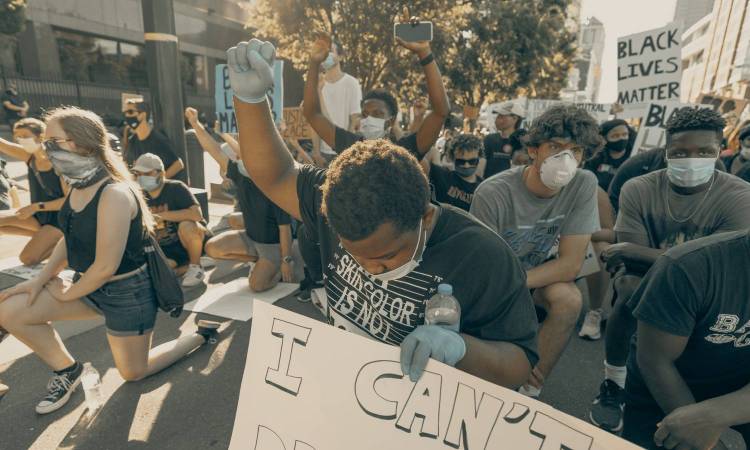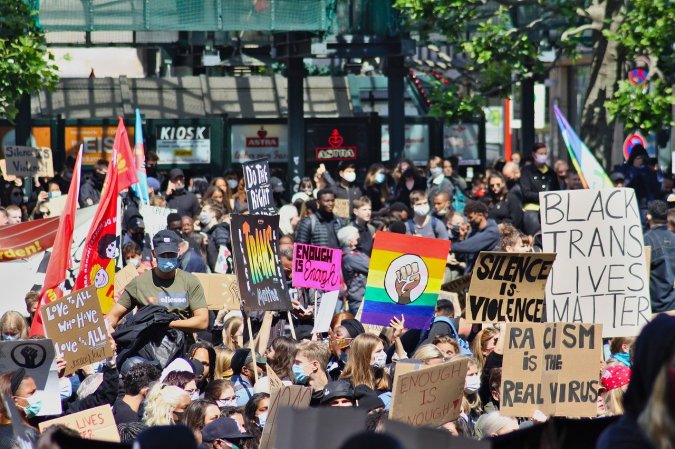

Anyone who has ever followed the news knows peaceful protests and demonstrations can quickly turn into dangerous affairs. When this happens, the result is nearly always the same: protesters get stuck in a thick, choking cloud of tear gas.
This may sound like something you won’t necessarily have to face, but it’s been happening for years and it’s happening right now around the world—people are being violently repressed and gassed during protests in places such as Hong Kong, Ecuador, Chile, Barcelona, and Lebanon.
Protesting is protected in most parts of the world by Article 19 of the Universal Declaration of Human Rights, which endows people with freedom of speech and expression. This universal right is included in most countries’ constitutions, too—such is the case in the U.S. with the First Amendment.
And even though protesting is your right and you may have every intention of keeping things peaceful, it’s also important to know what to do if those canisters start hissing. Protecting yourself and others should always be your top priority, and being prepared is by far the best way to start.
Tear gas 101
Contrary to its name, CS gas—the technical name for tear gas—is actually a crystalline powder that is converted into a fine spray and propelled from a grenade or canister by a small pyrotechnic explosion. This chemical was first developed in 1928 by American scientists, and after years of studies, it eventually became a weapon widely used by the U.S. military during the Vietnam War. Nowadays, tear gas is part of the crowd control arsenal of police and law enforcement agencies around the world, because it’s an easy way to disperse masses without the use of direct force.
“People just assume it’s safe, [but] it’s important to know that these weapons actually do cause injuries,” says Dr. Rohini Haar, an emergency physician, and a research fellow at the Human Rights Center at the University of California, Berkeley, School of Law.
The active component in tear gas—2-chlorobenzalmalononitrile—targets a specific receptor in the body called TRPA1, which serves mainly to send pain signals to the nervous system. When a tear gas canister explodes, CS powder sprays into the air and adheres to any moisture it can find—that means the tears in your eyes, the sweat on your skin, the grease in your hair, and the saliva and mucus that covers your mouth and airways.
When you’re exposed to tear gas, your eyes sting, your vision blurs, and you cry and blink uncontrollably. It gets worse the longer you’re in the gas: After a few seconds, you won’t be able to see, which will disorient and confuse you, potentially to the point of emotional and psychological distress.
But that’s not all. The powder also irritates your airways, making it hard to breathe, and causes your chest to tighten. You’ll start coughing automatically and your nose and mouth will secrete copious amounts of mucus and saliva, respectively. It’s a defense mechanism, but it will, paradoxically, make the symptoms even worse. Some people report feeling like they’re drowning in their own secretions and, if you don’t move out of the cloud, more mucus will only give the powder more to stick to.
“The body produces all these fluids and responses to expel this toxic irritant. In the case of tear gas, the response is very much exaggerated, and if people cannot escape, they get basically incapacitated,” says Sven-Eric Jordt, Ph.D., a professor of anesthesiology at Duke University School of Medicine, and part of the team responsible for discovering TRPA1’s role in tear gas response.
Yes, this is scary, but taking minimal precautions will help you reduce these symptoms, move to safety, and, hopefully, help others along the way.
Before exposure: be ready

Prepare your signs, your banners, and whatever you use to make some noise, but make sure you leave room for some essentials that will come in handy if you ever find yourself engulfed in a thickening cloud of gas. These precautions are key:
- Wear a scarf or bandana. The only completely effective way to protect yourself against tear gas is to wear a gas mask, but it’s highly likely you don’t have one of those just lying around the house. The next best thing is to cover your nose and mouth with a scarf or bandana, ideally one that’s been soaked in water. This will prevent the powder from getting into your airways, which will allow you to, well, breathe—which is always a good idea.
- Cover your head. If you can create an all-in-one solution with a big scarf that will cover your airways and your entire head, even better. If you don’t have one, a hat or beanie is a good complement to your mask. Make sure to cover as much of your head as possible, and if you have long hair, tie it up in a bun or braid—this will make it easier to get rid of the powder later on.
- Always wear goggles. They may not be the trendiest of accessories, but a pair of ski or swimming goggles tightly worn will prevent any tear gas particles from getting into your eyes. If you don’t have any and don’t want to buy them, sunglasses can also be useful, though they’re not ideal. Simple shades will only protect you from particles coming straight at you, but if the alternative is to go unprotected, sunglasses are better than nothing.
- Cover as much of your skin as possible. This may be a problem in warmer temperatures, but if you have to choose an outfit for a protest, the maxim is: The less skin, and the denser the fabric, the better. Forgo shorts and opt for long-sleeved shirts—that will mean less surface for the gas to adhere to. Note that CS powder does cling to your clothes, so if you’re exposed, you’ll need to change as soon as possible.
- Carry your things on your back. If you need to run, carrying an over-the-shoulder bag or a cross-body bag can be really uncomfortable. Especially when the only strap on your bag breaks and you end up running from water cannons while hugging your bag as a stranger pulls you along by your arm. I experienced exactly that during the student protests for quality education in Chile back in 2011. The lesson I learned was that if you need to carry something, it’s better to do it in a backpack or a drawstring bag. It’ll be much more comfortable if you ever have to make a run for it.
- Don’t forget your water. Whether it’s for drinking or washing your face, you should always have one or two bottles of clean water with you. If you’re able to identify clean water sources in the early stages of a protest or demonstration, try refilling your bottles as you go. Don’t touch stagnant water, like a fountain or pond, even if you’re desperate. For starters, it’s most likely gross, but pools of water can easily become contaminated with tear gas once it’s released into the air.
There are also things you should consider leaving at home if there’s a possibility you’ll be exposed to tear gas:
- Makeup. I do realize that forgoing mascara and lipstick may be a hard pass for some—nothing says “revolution” like red lips—but there is good reason for it. As mentioned above, the powder in tear gas clings to mucus and other bodily fluids, and since makeup has a similar watery, oily consistency, it will cling to it, too. If you are tear-gassed and you’re wearing eyeliner on your waterline, the powder will stick there. And, yeah, nope.
- Contact lenses. Same principle. Just imagine having tear gas powder trapped between your contacts and your eyeballs. Not a pretty sight. Literally.
During exposure: don’t panic (seriously)

Well, there’s nothing you could’ve done. You were there, raising your fist and banging your pot, but things took a turn for the worse and, next thing you know, you’re in the middle of a tear gas cloud. Don’t worry—it happens.
Even though most people report mostly manageable levels of pain and irritation, tear gas exposure can be a real problem for vulnerable people (children, the elderly, and pregnant women) and those with asthma or any sort of respiratory condition.
“Children are worse off because their lungs are much smaller, so the surface-to-volume ratio is very different from adults. They’re more at risk when they inhale it,” Jordt says.
Just as airplane safety videos have taught us, keep calm and secure your mask—or bandana, in this case—before helping others. Once you have your goggles on and your airways are covered, look around you and see if there’s anybody you can help.
If you see somebody either lying or sitting down or, it’s imperative to move them to a clean and ventilated area. CS powder is heavy, so once it’s aerosolized and propelled out of its canister, it will fall and settle—the closer to the ground, the higher the concentration of gas.
Once everybody who needs help has been dealt with, your top priority will be to move away from the tear gas cloud. Your first instinct will be to run, but fight against it—running will get you agitated, and before you know it, you’ll be taking in big gulps of air, filling your lungs with more tear gas, even if you’re wearing a mask. Move quickly, but make sure to keep your breathing even.
How to put out tear gas canisters

So far, these tips will allow you and your allies to move to a safer place and, hopefully, get back home to your loved ones. But if a gas canister lands right next to you, you may want to know how to put it out before it can release too much of its sinister payload. Be warned, though, that doing so is more dangerous than retreating, as it will bring you closer to the gas and the little fire that’s helping it disperse.
Videos of protesters in Hong Kong employing a number of creative methods to put out canisters went viral on social media, and were replicated by protesters in both Ecuador and Chile’s capital city, Santiago. Since CS gas is propelled out of its canister by a pyrotechnic explosion, putting out the fire inside is enough to make it stop. There are mainly two relatively safe ways to do this:
The traffic cone method
The principle is simple: cover a canister with a traffic cone to stop the spread of the gas, and use the opening at the top of the cone to pour water in it and put the fire in the canister out. This creative method stops the release of tear gas almost instantly. However, it’s not very efficient when it comes to water use—since you can’t properly aim at the canister inside the cone, you’ll need a lot of water, which is most likely in short supply.
The water bottle technique
Proceed with extreme caution: This method is much more dangerous, since it requires actually handling a hot, detonated tear gas canister or grenade. There are reports of people experiencing second degree burns when coming into direct contact with them. But the Hong Kong protesters figured it out: they used thick, heat-resistant leather gloves to pick up the canisters, put them inside metal water bottles, and shake them thoroughly until the fire in the canister was completely out. For this method, though, protection is key: Exposure to higher concentrations of CS powder make it absolutely necessary to have your eyes and airways thoroughly covered with a gas mask, and wearing appropriate, heat-resistant protection on your hands is a must to avoid burns.
After exposure: countermeasures and getting rid of the powder

If you search the internet, you’ll find a lot of possible remedies for the effects of tear gas, which have been used around the world during times of unrest. In 2014, protesters in Ferguson, Missouri, washed their faces with milk; in 2011, at demonstrations following the Arab Spring, Egyptian protesters soaked their bandanas in Coca-Cola; and last year, Palestinians used onions and vinegar to fight the effects of tear gas.
Hong Kong protesters carry around spray bottles with a baking soda and water solution (three teaspoons of powder for every 8.5 ounces of liquid), which they spray in their face and mouth to neutralize the effects of tear gas particles. Chilean protesters adopted this countermeasure and added it to their arsenal of traditional defenses against the chemical, which already included lemon wedges they suck on to clear their throats and airways.
Protesters swear by these techniques. But the only home-made countermeasure that may have some sort of scientific back-up (only one study so far), is the water and baking soda solution. According to the 2003 study, CS molecules are rather unstable and eventually break apart in a process called hydrolyzation. Basic, or less acidic pHs, such as baking soda, seem to accelerate the process, which would help stop the symptoms produced by tear gas.
“But there’s really no evidence behind any of this, and I would be very careful about advising anything other than just lots of fresh air and a lot of water,” Haar says.
And this is one of the main problems regarding tear gas: we just don’t know a lot about it. Most of the safety data governments around the world use come from studies done between the 1950s and 1970s, which means reports still cite data that’s up to 50 years old or even older.
“There are no additional studies really using advanced, up-to-date toxicological techniques. That’s very concerning. I’m not sure why this is. You don’t get much answers,” Jordt says.
The latest public data available about tear gas dates back to 2014, when the U.S. Army published a study that found that lung injuries in their recruits were the direct result of long exposure to 2-chlorobenzalmalononitrile.
“These are weapons,” Haar says. “They’re designed by weapons manufacturers, and so they continue to be updated or made stronger. But that research is not public—this is not approved by the [U.S. Food and Drug Administration], so there’s very little oversight of what exactly the chemicals are.”
Once you have escaped the cloud of tear gas, the next step is to get yourself clean as soon as possible. Take off your shoes outside of your home to keep them from bringing any powder indoors. Also shed all the clothes you were wearing and hang them in an open, ventilated area for at least 48 hours before washing them. Do not mix them with uncontaminated garments—wash them on their own twice or more, if necessary. CS powder can be active as long as five days after being released, so you want to make sure your clothes are clean before wearing them again.
Then, take a cold shower for at least 20 minutes—this will prevent tear gas from irritating your skin any further. You might have to shower a couple of times before you stop smelling of tear gas, but the first one will definitely reduce pain and irritation to a minimum. After that, you’ll be able to head right back out to the demonstration.
“The solution is not to not protest. That’s our human right,” Haar says. “But really, the ultimate solution is that these weapons are used far too often and they shouldn’t be.”














